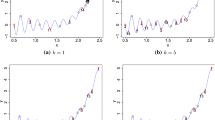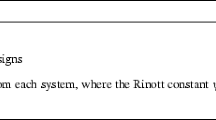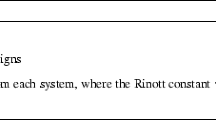Abstract
The utilization of multiple fidelity simulators for the design and analysis of computer experiments has received increased attention in recent years. In this paper, we study the contour estimation problem for complex systems by considering two fidelity simulators. Our goal is to design a methodology of choosing the best suited simulator and input location for each simulation trial so that the overall estimation of the desired contour can be as good as possible under limited simulation resources. The proposed methodology is sequential and based on the construction of Gaussian process surrogate for the output measure of interest. We illustrate the methodology on a canonical queueing system and evaluate its efficiency via a simulation study.






Similar content being viewed by others
References
Booker AJ, Dennis JE Jr, Frank PD, Serani DB, Torczon V (1999) A rigorous framework for optimization of expensive functions by surrogates. Struct Optim 17:1–13
Chuang SC, Hung YC (2010) Uniform design over general input domains with applications to target region estimation in computer experiments. Comput Stat Data Anal 54:219–232
Currin C, Mitchell TJ, Morris MD, Ylvisaker D (1991) Bayesian prediction of deterministic functions, with applications to the design and analysis of computer experiments. J Am Stat Assoc 86:953–963
Fang K-T, Lin DKJ, Winker P, Zhang Y (2000) Uniform design: theory and application. Technometrics 42:237–248
Forrester AIJ, Sobester A, Keane AJ (2007) Multi-fidelity optimization via surrogate modelling. Proc R Soc A 463:3251–3269
Gramacy RB, Lee HH (2008) Bayesian treed gaussian process models with an application to computer modeling. J Am Stat Assoc 103:1119–1130
Hung YC, Michailidis G (2008) Modeling, scheduling, and simulation of switched processing systems. ACM Trans Model Comput Simul 18:3
Jones DR, Schonlau M, Welch WJ (1998) Efficient global optimization of expensive black-box functions. J Glob Optim 13:455–492
Joseph VR (2006) Limit kriging. Technometrics 48:458–466
Joseph VR, Hung Y, Sudjianto A (2008) Blind kriging: a new method for developing metamodels. J Mech Des 130:0311021-1-8
Kennedy MC, O’Hagan A (2000) Predicting the output from a complex computer code when fast approximations are available. Biometrika 87:1–13
McKay MD, Beckman RJ, Conover WJ (1979) A comparison of three methods for selecting values of input variables in the analysis of output from a computer code. Technometrics 21:239–245
Mitchell TJ, Morris MD (1992) Bayesian design and analysis of computer experiments: two examples. Stat Sin 2:359–379
Qian PZG, Ai M, Wu CFJ (2009) Construction of nested space-filling designs. Ann Stat 37:3616–3643
Qian PZG, Wu CFJ (2008) Bayesian hierarchical modeling for integrating low-accuracy and high-accuracy experiments. Technometrics 50:192–204
Qian Z, Seepersad CC, Joseph VR, Allen JK, Wu CFJ (2006) Building surrogate models based on detailed and approximate simulations. J Mech Des 128:668–677
Ranjan P, Bingham D, Michailidis G (2008) Sequential experiment design for contour estimation from complex computer codes. Technometrics 50:527–541
Ranjan P, Bingham D, Michailidis G (2011) Errata: Sequential experiment design for contour estimation from complex computer codes. Technometrics 53:109–111
Rennen G, Husslage B, Dam ERV, Hertog DD (2010) Nested maximin Latin hypercube designs. Struct Multidiscip Optim 41:371–395
Sacks J, Schiller SB, Welch WJ (1989a) Design for computer experiments. Technometrics 31:41–47
Sacks J, Welch WJ, Mitchell TJ, Wynn HP (1989b) Design and analysis of computer experiments. Stat Sci 4:409–423
Welch WJ, Buck RJ, Sacks J, Wynn HP, Mitchell TJ, Morris MD (1992) Screening, predicting, and computer experiments. Technometrics 34:15–25
Acknowledgments
The authors are grateful to the anonymous reviewers for their suggestions and comments. This work is partially supported by the National Science Council under grant NSC 98-2118-M-390-002-(Chen) and 100-2628-M-002-011-MY4 (Wang), Taida Institute for Mathematical Sciences, National Center for Theoretical Sciences (Taipei Office) and the Mathematics Division of the National Center for Theoretical Sciences (South) in Taiwan.
Author information
Authors and Affiliations
Corresponding author
Rights and permissions
About this article
Cite this article
Chen, RB., Hung, YC., Wang, W. et al. Contour estimation via two fidelity computer simulators under limited resources. Comput Stat 28, 1813–1834 (2013). https://doi.org/10.1007/s00180-012-0380-7
Received:
Accepted:
Published:
Issue Date:
DOI: https://doi.org/10.1007/s00180-012-0380-7




